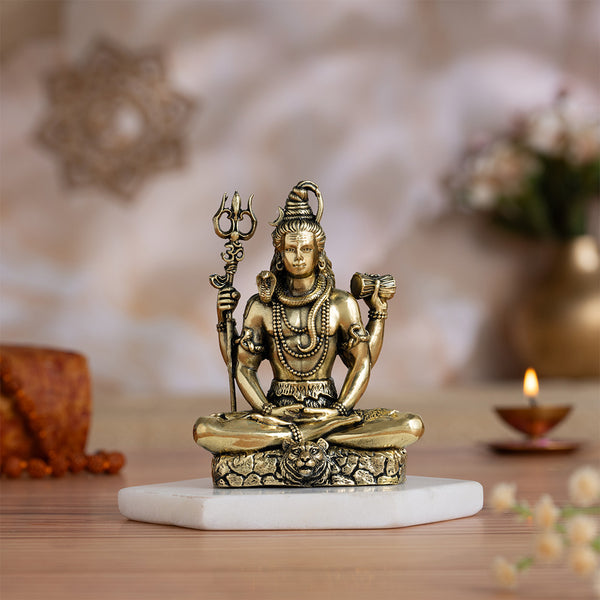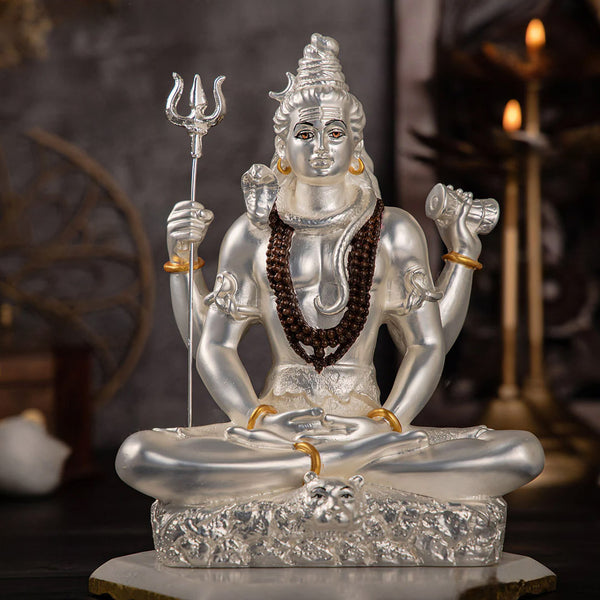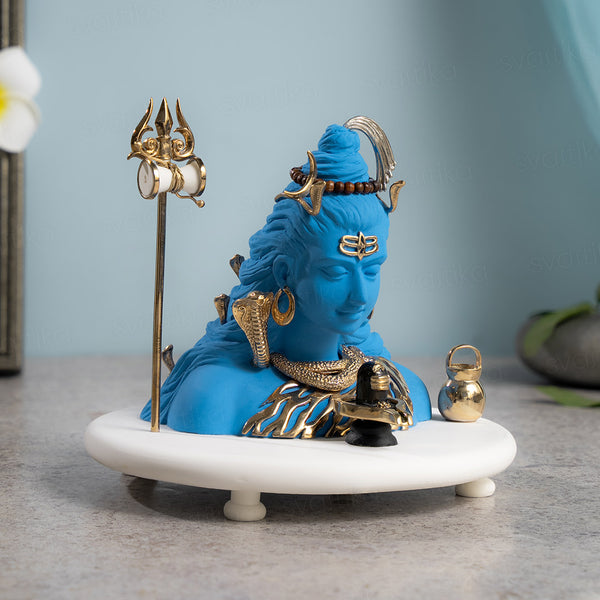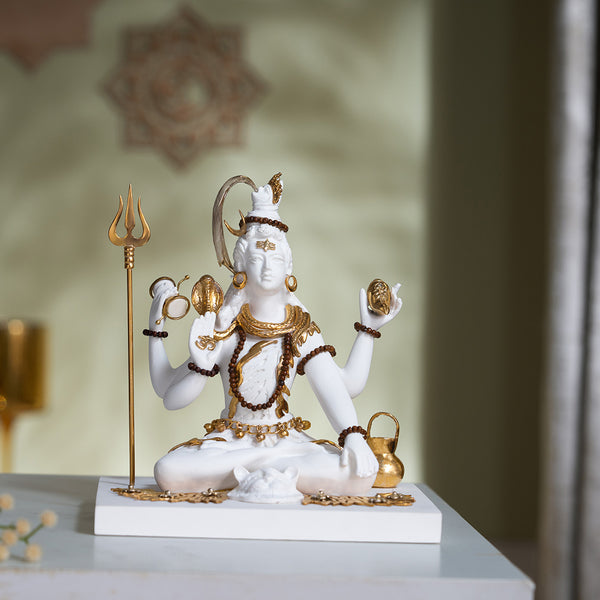Lord Shiva, often hailed as the Adiyogi, holds a central place in Hinduism, embodying the essence of the universe itself. Imagine Lord Shiva as a cosmic symphony, harmonizing the dance of existence with his movements. He’s revered not just for his cosmic dance but also for his roles as both the destroyer and transformer of worlds. His wisdom spans beyond mere understanding, touching upon the deepest truths of existence. Lord Shiva is a figure of contradictions and balances—destruction and creation, asceticism and sensuality, solitude and community. He can be a fierce warrior one moment and a serene yogi the next, illustrating the divine paradox that mirrors the very fabric of the cosmos.
In Hindu tradition, avatars are more than just incarnations—they’re divine interventions designed to guide and protect humanity. These avatars are like the various masks a deity wears to interact with the world. For Lord Shiva, these avatars are particularly intriguing. They showcase not only his cosmic roles but also his profound connection with all aspects of life. While some texts hint at a virtually endless number of forms Lord Shiva might take, there’s a particular focus on nineteen principal avatars that are especially noteworthy. Each of these forms has its own unique story and spiritual significance, reflecting Lord Shiva’s boundless nature and his impact across different realms of existence.
Brass Lord Shiva Meditating Idol (4 Inch) Lord Shiv Murti - Silver Plated (8 Inch)

The Legendary Tales of Lord Shiva’s 19 Avatars
The concept of Lord Shiva's avatars spans a wide range of texts and traditions, each offering a unique perspective on his divine manifestations. These avatars are not merely mythical stories; they encapsulate deeper spiritual truths and cosmic principles. Let’s see the nineteen principal avatars of Lord Shiva, each representing different facets of his divine role.

The Nineteen Avatars of Lord Shiva
1. Piplaad Avatar
The Piplaad Avatar is associated with the rejuvenation of the sacred Piplaad tree. This avatar symbolizes Lord Shiva’s role in restoring vitality and balance to nature. The story goes that the Piplaad tree, once sacred, had withered away. Lord Shiva, in the form of Piplaad, restored it, demonstrating his power to renew and heal the natural world. This form emphasizes the divine ability to bring life and regeneration, reinforcing the interconnectedness between the divine and the natural world.
2. Nandi Avatar
Nandi, the bull, is not merely Lord Shiva’s mount but also an important avatar. Nandi represents loyalty, devotion, and strength. In this avatar, Lord Shiva manifests as the steadfast bull, symbolizing unwavering support for righteous causes and the divine protection of dharma. Nandi’s presence in Lord Shiva’s mythology underscores the importance of devotion and the support the divine provides to those who uphold moral and cosmic order.
3. Veerabhadra Avatar
Veerabhadra is one of the most dramatic and fierce avatars of Lord Shiva. This form emerged from Lord Shiva’s intense anger following the self-immolation of his consort, Sati. Veerabhadra’s role was to challenge and destroy the forces that opposed cosmic order. His actions are a powerful testament to Lord Shiva’s ability to wield righteous anger as a means of restoring balance and justice. Veerabhadra represents the dynamic and sometimes disruptive forces necessary for the preservation of dharma.
4. Bhairava Avatar
Bhairava, another fearsome aspect of Lord Shiva, is known for his terrifying and transformative energy. This avatar is often associated with the annihilation of evil and the purification of the soul. Bhairava’s presence signifies the destructive aspect of Lord Shiva that clears away the old and unworthy, making way for renewal and purity. This form embodies the transformative power of divine intervention, emphasizing the necessity of destruction in the cyclical nature of existence.
5. Ashwatthama Avatar
Ashwatthama, a character from the Mahabharata, is sometimes considered an avatar of Lord Shiva. This association reflects Lord Shiva’s role in maintaining cosmic order through complex means. Ashwatthama’s story, marked by intense devotion and complex moral dilemmas, highlights the challenges of upholding justice and the divine’s role in navigating these challenges. This avatar underscores the interplay between divine will and human actions.
6. Sharabha Avatar
Sharabha is a unique avatar where Lord Shiva appears as a mythical creature with the features of various animals. This form symbolizes Lord Shiva’s power to transcend limitations and embody the essence of diverse beings. The Sharabha Avatar represents Lord Shiva’s role as a cosmic force that transcends conventional forms and limitations, emphasizing the divine’s ability to adapt and overcome challenges.
7. Grihapati Avatar
The Grihapati Avatar represents Lord Shiva’s connection with domestic life and the household. In this form, Lord Shiva embodies the virtues of family life, stability, and harmony. This avatar highlights the divine presence in everyday life and the importance of maintaining balance and peace within the family unit. Grihapati’s role underscores the idea that the divine is present in all aspects of human experience, not just in the grand or dramatic.
8. Durvasa Avatar
Durvasa, the ascetic sage known for his temper, is also considered an avatar of Lord Shiva. This form reflects Lord Shiva’s role in embodying the virtues of penance and devotion. Durvasa’s presence in the mythology serves as a reminder of the importance of humility and the consequences of pride. This avatar teaches the value of spiritual discipline and the potential for divine retribution in the face of arrogance.
9. Rishabha Avatar
Rishabha, often associated with the sacred bull, signifies Lord Shiva’s role in guiding humanity towards righteousness. This avatar symbolizes divine guidance and the nurturing of spiritual wisdom. Rishabha’s form emphasizes the divine’s role in leading beings towards moral and spiritual integrity, highlighting the importance of righteous conduct and spiritual development.
10. Yatinath Avatar
The Yatinath Avatar represents Lord Shiva’s ascetic and meditative aspects. As Yatinath, Lord Shiva embodies the virtues of renunciation and spiritual discipline. This form underscores Lord Shiva’s role as the ultimate yogi, reflecting the importance of meditation and self-control in spiritual practice. Yatinath’s presence highlights the transformative power of asceticism and the pursuit of spiritual enlightenment.
11. Hanuman Avatar
Hanuman, the devoted monkey god, is sometimes considered an avatar of Lord Shiva. This association illustrates Lord Shiva’s role in the broader context of divine manifestations and his recognition of other forms of divinity. Hanuman’s devotion and strength are celebrated as qualities that align with Lord Shiva’s divine principles, showcasing the interconnectedness of various deities within the Hindu pantheon.
12. Krishna Darshan Avatar
The Krishna Darshan Avatar reflects Lord Shiva’s divine vision and acknowledgment of other incarnations. This form represents Lord Shiva’s recognition of the divinity in Krishna, emphasizing the unity and respect among different divine forms. Krishna Darshan highlights Lord Shiva’s role in embracing and honoring other manifestations of the divine, showcasing the interconnectedness of divine manifestations.
13. Bhikshuvarya Avatar
Bhikshuvarya represents Lord Shiva’s mendicant aspect, wandering the world in search of alms. This avatar underscores the values of detachment, humility, and spiritual quest. Bhikshuvarya’s role emphasizes the importance of renunciation and the pursuit of spiritual wisdom beyond material wealth, reflecting Lord Shiva’s role as a spiritual wanderer and seeker.
14. Sureshwar Avatar
Sureshwar, the divine of the gods, represents Lord Shiva’s supreme authority and role as the overseer of the cosmic order. This form highlights Lord Shiva’s role in maintaining harmony and balance among the deities and the cosmos. Sureshwar’s presence underscores the divine authority that governs and guides the universe, reflecting Lord Shiva’s supreme status and cosmic significance.
15. Keerat Avatar
The Keerat Avatar, where Lord Shiva appears as a hunter, symbolizes his connection with the wilderness and natural world. This form emphasizes Lord Shiva’s role in the untamed aspects of existence and his interactions with nature. Keerat’s presence highlights Lord Shiva’s ability to transcend societal norms and connect with the primal forces of the natural world.
16. Sunatnartak Avatar
Sunatnartak, the divine dancer, embodies Lord Shiva’s cosmic dance that brings rhythm and order to the universe. This avatar represents the dynamic and creative energy of the divine, emphasizing the importance of harmony and balance. Sunatnartak’s role highlights the interplay of creation and destruction, showcasing the divine’s influence on the cosmic dance.
17. Brahmachari Avatar
The Brahmachari Avatar reflects Lord Shiva’s role as the eternal celibate, embodying purity and self-discipline. This form emphasizes the value of spiritual focus and the renunciation of worldly desires. Brahmachari’s presence highlights the importance of asceticism and the pursuit of spiritual enlightenment, representing the divine’s role in guiding seekers toward spiritual realization.
18. Yaksheshwar Avatar
Yaksheshwar, the deity of nature spirits and elemental forces, symbolizes Lord Shiva’s role in maintaining the balance between the natural and supernatural realms. This form represents Lord Shiva’s connection with the elemental forces of nature and his role in harmonizing these forces. Yaksheshwar’s presence highlights the divine’s influence on both the physical and spiritual aspects of existence.
19. Avadhut Avatar
The Avadhut Avatar represents the ultimate ascetic form of Lord Shiva, embodying the highest state of spiritual realization and liberation. This form showcases Lord Shiva’s role in attaining divine wisdom and the culmination of spiritual practice. Avadhut’s presence emphasizes the pursuit of spiritual enlightenment and the realization of the divine self.

The Spiritual Significance and Cosmic Symbolism
Luxurious Blue Neelkanth Shiva Idol - Gold Plated (6.25 Inch) Premium White & Gold Plated Shiva Statue With Trishul

The avatars of Lord Shiva are not merely narratives; they are imbued with profound spiritual significance and cosmic symbolism. Each avatar represents different facets of divine intervention, illustrating how the Supreme Being engages with the world to maintain cosmic order and guide humanity. The avatars embody various aspects of creation, preservation, destruction, and transformation, reflecting the cyclical nature of existence






